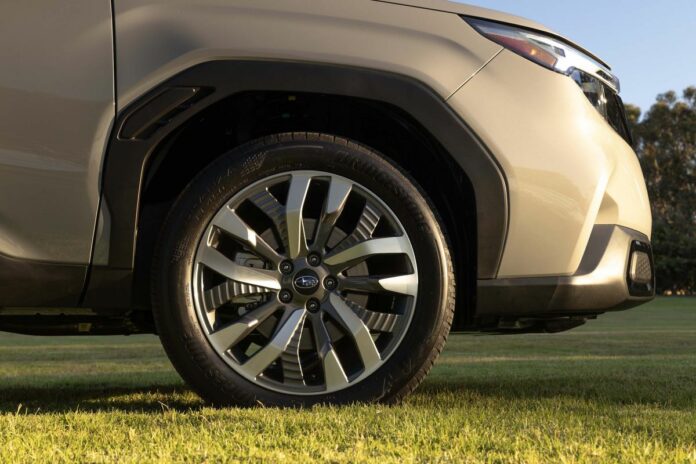2025 Subaru Forester Hybrid
In the rapidly evolving landscape of the automotive industry, where environmental sustainability and technological advancement converge, Subaru stands poised to make a significant leap. The 2025 Subaru Forester, a model synonymous with reliability and versatility, is set to embrace this paradigm shift.
Subaru Hybrid Technology
Key Points
- The 2025 Subaru Forester will be joined by a hybrid model a year after its launch.
- This will be the first-ever Subaru Forester Hybrid.
- Subaru does not currently offer any hybrids in the U.S., but a Crosstrek plug-in hybrid is expected to arrive soon.
- Many of the Forester’s rivals offer hybrid powertrains.
- The 2025 Forester will arrive at dealers in the spring of 2024, and the hybrid model is expected to arrive for the 2026 model year.

Eco-Friendly SUV
While retaining its iconic 2.5-litre naturally aspirated flat-four engine, a hallmark of its predecessors, the Forester is expanding its horizons. The introduction of a hybrid variant not only marks a milestone in Subaru’s product lineup but also reflects a broader industry trend towards hybrid and electric vehicles. This report delves into the nuances of the 2025 Forester’s development, its positioning in a competitive market, and the implications of Subaru’s strategic pivot towards electrification. Here are some key points from your summary:
- Engine Continuity with Predecessor: The 2025 Subaru Forester retains the 2.5-liter naturally aspirated flat-four engine from its previous model. This indicates a level of continuity in performance and design.
- Introduction of a Hybrid Model: A significant development is the planned introduction of a hybrid Forester. This marks Subaru’s ongoing commitment to electrification and adaptation to the changing market demands.
- Not the First Electrified Forester: Although the upcoming hybrid Forester is a new venture for the U.S. market, it’s not the first electrified Forester. The e-Boxer hybrid powertrain was previously offered in Europe, indicating Subaru’s gradual approach towards electrification.
- Market Context: Subaru’s move to introduce a hybrid Forester aligns with the trends set by its competitors. Major rivals like Toyota, Honda, Kia, and Hyundai are already offering hybrid and, in some cases, plug-in hybrid options. This suggests that Subaru is keen on maintaining competitiveness in a rapidly evolving market.
- Launch Timeline: The 2025 Forester is expected to arrive at dealers in the next spring, with the hybrid model likely introduced for the 2026 model year. This timeline reflects the auto industry’s expedited shift towards hybrid and electric vehicles.
- Broader Industry Trend: Subaru’s strategy is indicative of the auto industry’s larger trend towards electrification. As environmental concerns and regulatory pressures grow, automakers are increasingly focusing on hybrids as a transitional technology towards fully electric vehicles.
Automotive Electrification
The introduction of the 2025 Subaru Forester Hybrid comes with its own set of advantages and disadvantages:
Pros:
- Environmental Impact: The hybrid model will likely offer better fuel efficiency compared to its purely internal combustion engine counterparts, leading to reduced emissions and a smaller carbon footprint.
- Performance Benefits: Hybrids often provide better torque and smoother acceleration due to the electric motor, which can enhance the driving experience.
- Reduced Fuel Costs: Owners of the hybrid Forester can expect to spend less on fuel, thanks to the efficiency of hybrid powertrains.
- Tax Incentives and Rebates: In many regions, owning a hybrid vehicle qualifies for tax incentives, rebates, or other benefits, making it a financially attractive option.
- Market Competitiveness: Offering a hybrid version allows Subaru to remain competitive in a market where rivals like Toyota, Honda, and Hyundai already have hybrid offerings.
- Brand Image: Introducing a hybrid model aligns Subaru with the growing trend of sustainability, potentially enhancing the brand’s image among environmentally conscious consumers.
Cons:
- Higher Initial Cost: Hybrid vehicles typically come with a higher initial price tag compared to their non-hybrid counterparts due to the additional technology and components involved.
- Battery Replacement and Disposal: Over time, the battery in a hybrid vehicle may need replacement, which can be costly. Additionally, disposing of old hybrid batteries poses environmental concerns.
- Complexity and Maintenance: Hybrids are generally more complex than traditional cars, which could mean potentially higher maintenance costs and the need for specialized service.
- Weight and Space Considerations: The battery and hybrid system components add weight and can take up more space, possibly affecting the vehicle’s handling and interior space.
- Limited Model Options: Initially, the hybrid option may be available in a limited number of trims or configurations, restricting choices for buyers.
- Uncertain Resale Value: The resale value of hybrid vehicles can be unpredictable, influenced by factors like battery health and advancements in newer technologies.
While the 2025 Subaru Forester Hybrid will offer significant environmental and performance benefits, potential buyers should also consider factors like cost, maintenance, and practicality when making their decision.
Fuel Efficiency in SUVs
Conclusion
The introduction of the hybrid 2025 Subaru Forester represents more than just an addition to a well-established model line; it signifies a pivotal moment in Subaru’s adaptation to a changing automotive landscape. By integrating hybrid technology, Subaru is not only responding to the competitive pressures from rivals but also aligning with the global shift towards more sustainable transportation solutions.
The hybrid Forester, expected to hit the market by the 2026 model year, is a testament to Subaru’s commitment to innovation and environmental responsibility. As the automotive world continues its inexorable march towards electrification, Subaru’s foray into hybrid technology with the Forester positions the brand as both a follower and a leader in this transformative era.





































